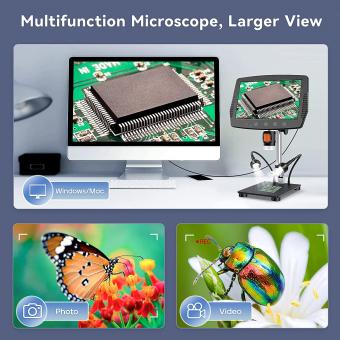Can We See Atoms Under An Electron Microscope ?
Yes, atoms can be seen under an electron microscope. Electron microscopes use a beam of electrons instead of light to magnify the sample being observed. The shorter wavelength of electrons allows for much higher resolution compared to traditional light microscopes. By manipulating the electron beam and detecting the scattered electrons, it is possible to create an image of the atomic structure of a sample. This technique, known as transmission electron microscopy (TEM), has been instrumental in advancing our understanding of the atomic world.
1、 Atomic resolution imaging with electron microscopy techniques
Yes, we can see atoms under an electron microscope. Electron microscopy techniques have revolutionized our ability to observe and study the atomic structure of materials. The development of high-resolution electron microscopes has allowed scientists to achieve atomic resolution imaging, enabling us to directly visualize individual atoms.
Electron microscopes use a beam of electrons instead of light to image samples. The shorter wavelength of electrons compared to visible light allows for much higher resolution imaging. With modern electron microscopes, it is possible to achieve a resolution of less than 0.1 nanometers, which is smaller than the size of an atom.
In recent years, advancements in electron microscopy techniques have further improved our ability to see atoms. For example, aberration-corrected electron microscopy has significantly reduced the blurring and distortion caused by lens imperfections, resulting in sharper and more detailed images. This technique has allowed scientists to directly observe individual atoms and even distinguish between different atomic species.
Furthermore, the development of scanning transmission electron microscopy (STEM) has enabled atomic resolution imaging with elemental mapping capabilities. STEM can provide information about the chemical composition of a sample by measuring the energy loss of the transmitted electrons, allowing us to identify specific atoms and their arrangements within a material.
It is important to note that while electron microscopy techniques can provide atomic resolution imaging, the interpretation of the images requires expertise and careful analysis. The contrast in the images is influenced by various factors, including the atomic number, crystal orientation, and imaging conditions. Therefore, the interpretation of atomic structures from electron microscopy images often involves a combination of experimental observations, theoretical calculations, and computer simulations.
In conclusion, electron microscopy techniques have made it possible to see atoms with atomic resolution. Ongoing advancements in electron microscopy continue to push the boundaries of our ability to observe and understand the atomic world, opening up new opportunities for scientific discoveries and technological advancements.

2、 Limitations of electron microscopy in visualizing individual atoms
Limitations of electron microscopy in visualizing individual atoms
Electron microscopy has revolutionized our understanding of the microscopic world by providing detailed images of structures at the atomic level. However, there are limitations to this technique when it comes to visualizing individual atoms.
One of the main limitations is the resolution of the electron microscope. The resolution of an electron microscope is limited by the wavelength of the electrons used. Although electrons have a much smaller wavelength than visible light, they still have a finite size. This means that there is a limit to how small of a feature can be resolved. Currently, the highest resolution achieved with electron microscopy is around 50 picometers, which is close to the size of an atom. However, this is still not sufficient to directly visualize individual atoms.
Another limitation is the sensitivity of the sample to the electron beam. Electron microscopy requires the sample to be placed in a vacuum, which can cause damage to the sample. Additionally, the high-energy electrons used in the microscope can also cause radiation damage to the sample. This limits the types of samples that can be studied and the amount of time the sample can be exposed to the electron beam.
Furthermore, electron microscopy is limited by the fact that it provides a two-dimensional projection of a three-dimensional object. This can make it difficult to accurately determine the positions of individual atoms within a structure.
Despite these limitations, recent advancements in electron microscopy techniques have shown promise in visualizing individual atoms. For example, aberration-corrected electron microscopy has improved the resolution and clarity of images, allowing for better visualization of atomic structures. Additionally, techniques such as electron holography and electron tomography have been developed to provide three-dimensional information about atomic arrangements.
In conclusion, while electron microscopy has greatly advanced our understanding of the microscopic world, there are still limitations in directly visualizing individual atoms. However, ongoing research and technological advancements continue to push the boundaries of electron microscopy, offering hope for future breakthroughs in atomic imaging.

3、 Advances in electron microscopy for atomic-scale imaging
Yes, we can see atoms under an electron microscope. Electron microscopy has revolutionized our ability to observe and understand the atomic structure of materials. The resolution of electron microscopes has improved significantly over the years, allowing us to visualize individual atoms and their arrangements.
The latest advances in electron microscopy have further enhanced our ability to image atoms at the atomic scale. One such breakthrough is the development of aberration-corrected electron microscopy. This technique corrects for the imperfections in the electron lenses, resulting in improved resolution and clarity in the images obtained. With aberration correction, it is now possible to directly observe individual atoms and even their chemical bonding.
Another recent development is the use of scanning transmission electron microscopy (STEM) combined with energy-dispersive X-ray spectroscopy (EDS). This technique allows for simultaneous imaging and elemental analysis at the atomic scale. By mapping the distribution of different elements within a material, we can gain valuable insights into its composition and structure.
Furthermore, advancements in electron microscopy have also led to the development of in-situ techniques, where materials can be observed under real-world conditions. This enables us to study dynamic processes, such as chemical reactions or phase transformations, at the atomic level.
In summary, advances in electron microscopy have made it possible to see atoms under the microscope. With techniques like aberration correction, STEM-EDS, and in-situ imaging, we can now obtain atomic-scale images with unprecedented resolution and detail. These advancements have greatly contributed to our understanding of materials and have opened up new avenues for scientific research and technological advancements.

4、 Techniques for indirect visualization of atoms using electron microscopy
No, we cannot directly see individual atoms under a conventional electron microscope. The resolution of a typical electron microscope is limited to a few angstroms, which is not sufficient to resolve individual atoms. However, there are techniques for indirect visualization of atoms using electron microscopy.
One such technique is high-resolution transmission electron microscopy (HRTEM), which can provide atomic-scale imaging of crystalline materials. HRTEM uses a highly focused electron beam to interact with the sample, and the resulting electron scattering patterns can be used to reconstruct an image of the atomic structure. By analyzing the diffraction patterns, it is possible to determine the positions of the atoms within the crystal lattice.
Another technique is scanning transmission electron microscopy (STEM), which can provide atomic-scale imaging and spectroscopy. STEM uses a focused electron beam to scan across the sample, and the transmitted electrons are collected to form an image. By analyzing the intensity and energy of the transmitted electrons, it is possible to obtain information about the atomic composition and bonding.
Recent advancements in electron microscopy, such as aberration correction and the development of new detectors, have significantly improved the resolution and sensitivity of these techniques. This has allowed researchers to visualize individual atoms and even observe their movements in real-time. However, it is important to note that these techniques still rely on indirect methods to visualize atoms, and the interpretation of the images requires careful analysis and modeling.
In summary, while we cannot directly see atoms under a conventional electron microscope, techniques such as HRTEM and STEM allow for indirect visualization of atoms at the atomic scale. Ongoing advancements in electron microscopy continue to push the boundaries of resolution and sensitivity, enabling researchers to gain deeper insights into the atomic world.







































